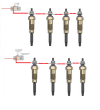I am confused. From earlier posts I understood that the new parallel kit would not be wired to the ballast resistor as per older pigtail ones but to the thick brown/red input wire, effectively by passing the resistor with 12 v going to the plugs.
The instructions on my Britpart kit (see attached) state that the original ballast resistor connections should be retained, which is the opposite of what I and many others understood.
Help!
Faber
The instructions on my Britpart kit (see attached) state that the original ballast resistor connections should be retained, which is the opposite of what I and many others understood.
Help!
Faber
